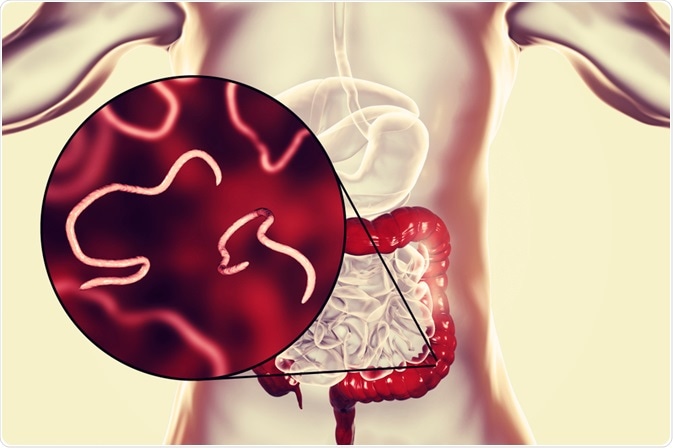Threadworm is a very common infection that occurs when tiny, thread-like worms infest the human intestine. The worms, which are between 2 and 13 millimeters (mm) long and resemble a piece of white thread, are also sometimes referred to as pinworms. Female worms are longer than male worms, measuring at least 1 centimeter (cm) and having a diameter of just under 1 mm.

Image Credit: Kateryna Kon / Shutterstock.com
Threadworms are the most common parasite found in children from the United Kingdom, with as many as half of those aged under 10 being infected. The risk of an infected child’s family member also becoming infected is as high as 75%. To date, the only hosts that these worms have are humans.
Threadworm is treated with drugs that kill the worms them and by washing any linen or underwear that may be contaminated with eggs laid by the female. Ideally, the infected child and all their family members should be treated.
Although threadworm often does not cause any symptoms, some of the signs of this infection that may manifest include insomnia and restlessness, itching in the vaginal or anal area, abdominal pain, and nausea.
Transmission
Adult threadworms reside in the gut but move down towards the anus at night to lay their eggs around the anus or vagina of an infected person. The female worm lays around 11,000 eggs and also secretes a special mucus that irritates the skin, which is why this area becomes particularly itchy at night in infected individuals.
If a person scratches these areas to relieve itching, the eggs can easily stick to the fingertips or be picked up underneath the fingernails. From there, the eggs can be transmitted to the mouth through the fecal-oral mode of transmission, or to the surface of various materials and objects such as clothes, utensils, and toys. Once transferred to surfaces, the eggs can survive for weeks and be transmitted by uninfected individuals who happen to touch the contaminated items.
Although eggs are usually swallowed and ingested, they can also be inhaled, which may occur when infected towels, sheets, or blankets are shaken, thus allowing the eggs to disperse into the air.
Threadworm eggs are resilient and can survive for up to three weeks before they hatch. If eggs hatch around the anus, they re-enter the bowels or gut as tiny, newborn worms. If the eggs have entered via the mouth, they hatch in the small intestine and pass through the gut to reach the large intestine.
It takes around two weeks for the worms to become adults and begin laying eggs, at which point the cycle of infection starts again. The worms can live for as long as six weeks.
Although threadworms do not infect animals, there is a small risk of infection from stroking or petting animals because the eggs can be carried on their fur.
The reason threadworm mainly affects children is that they are often less aware of the importance of hygiene and fail to wash their hands or keep their hands away from their mouths. Children are likely to prolong infection by continually touching their mouths with their infected hands. They are also likely to infect other children who they come into contact with by sharing toys or holding their hands.
Risk factors
Some of the risk factors for threadworm infection are described below.
- Young age – Children are at the greatest risk of infection because the microscopic eggs are so easily spread through hand to mouth contact and toy sharing.
- Crowded living spaces – People living in crowded living quarters such as institutions are at a higher risk of becoming infected.
- Temperate climate – Although threadworm infection occurs across the world, it is more common in countries that are not tropical in climate.
References
Last Updated: Jun 14, 2023